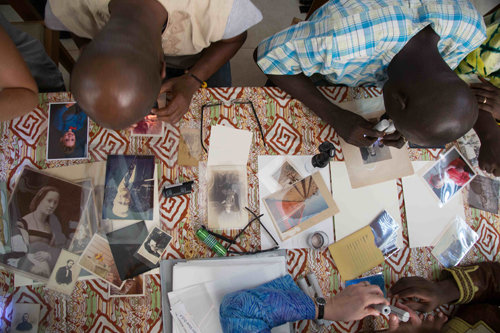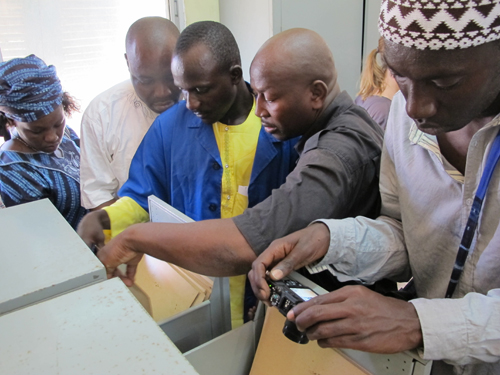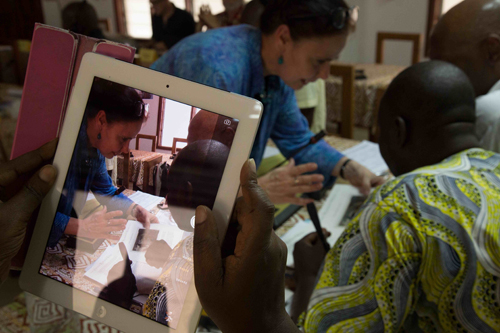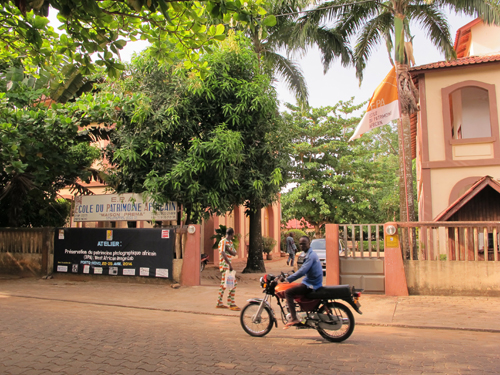 Traveling Exhibitions
Traveling Exhibitions Traveling Works of Art
Traveling Works of Art Conservation Projects
Conservation Projects Excavations
Excavations Fellows
Fellows Exchanges & Collaborations
Exchanges & Collaborations Multiple Items
Multiple Items
The Met Around the World presents the Met’s work via the global scope of its collection and as it extends across the nation and the world through a variety of domestic and international initiatives and programs, including exhibitions, excavations, fellowships, professional exchanges, conservation projects, and traveling works of art.
The Met Around the World is designed and maintained by the Office of the Director.
Traveling
Exhibitions
The Met organizes large and small exhibitions that travel beyond the Museum's walls, extending our scholarship to institutions across the world. See our national and international traveling exhibition program from 2009 to the present.
Traveling
Works of Art
The Met lends works of art to exhibitions and institutions worldwide to expose its collection to the broadest possible audience. See our current national and international loans program.
Conservation
Projects
The preservation of works of art is a fundamental part of the Met's mission. Our work in this area includes treating works of art from other collections. See our national and international conservation activities from 2009 to the present.
Excavations
The Met has conducted excavations for over 100 years in direct partnership with source countries at some of the most important archaeological sites in the world. Today we continue this tradition in order to gain greater understanding of our ancient collections. See our national and international excavation program from the Met's founding to the present.
Fellows
The Met hosts students, scholars, and museum professionals so that they can learn from our staff and pursue independent research in the context of the Met's exceptional resources and facilities. See the activities of our current national and international fellows.
Exchanges & Collaborations
The Met's work takes many forms, from participation in exchange programs at partnering institutions and worldwide symposia to advising on a range of museum issues. These activities contribute to our commitment to advancing the work of the larger, global community of art museums. See our national and international exchange program and other collaborations from 2009 to the present.
 Magnification is one of the tools helpful in differentiating an albumen print from a silver gelatin from a contemporary inkjet print. Pictured here are participants from Burkina Faso, Côte d'Ivoire, and Benin working with Nora Kennedy, Sherman Fairchild Conservator in Charge of the Department of Photograph Conservation at The Metropolitan Museum of Art. Photograph © Caroline Lacey / Resolution Photo.
Magnification is one of the tools helpful in differentiating an albumen print from a silver gelatin from a contemporary inkjet print. Pictured here are participants from Burkina Faso, Côte d'Ivoire, and Benin working with Nora Kennedy, Sherman Fairchild Conservator in Charge of the Department of Photograph Conservation at The Metropolitan Museum of Art. Photograph © Caroline Lacey / Resolution Photo. Debbie Hess Norris, University of Delaware, and Nora Kennedy, The Metropolitan Museum of Art, discuss subtleties of image color, surface characteristics, format, and condition to aid in identification of photographic processes with colleagues from Benin and Senegal. Photograph © Caroline Lacey / Resolution Photo.
Debbie Hess Norris, University of Delaware, and Nora Kennedy, The Metropolitan Museum of Art, discuss subtleties of image color, surface characteristics, format, and condition to aid in identification of photographic processes with colleagues from Benin and Senegal. Photograph © Caroline Lacey / Resolution Photo.
Left to right: Sonia Mahamé (Benin), Debbie Hess Norris (USA), Nora Kennedy (USA), Ibrahima Thiam (Senegal), and Ezéchiel Méhomé (Benin). The workshop commenced with visits to local collections in Porto-Novo, Benin. Here Alphonse Olibé welcomes colleagues from Benin, Mali, and Senegal to the Centre Béninois de Recherche Scientifique et Technique (CBRST). Photograph © Nora Kennedy.
The workshop commenced with visits to local collections in Porto-Novo, Benin. Here Alphonse Olibé welcomes colleagues from Benin, Mali, and Senegal to the Centre Béninois de Recherche Scientifique et Technique (CBRST). Photograph © Nora Kennedy.
Left to right: Sonia Mahamé (Benin), Léonce Agbodjelou (Benin), Alphonse Olibé (Benin), Adama Bamba (Mali), and Ibrahima Thiam (Senegal). The cusp between analog photography and digital imaging presents new challenges for collection keepers. Although digital imaging is used almost exclusively, its preservation requires a great deal more active engagement than older collections of analog negatives and prints. Photograph © Caroline Lacey / Resolution Photo.
The cusp between analog photography and digital imaging presents new challenges for collection keepers. Although digital imaging is used almost exclusively, its preservation requires a great deal more active engagement than older collections of analog negatives and prints. Photograph © Caroline Lacey / Resolution Photo. L'École du Patrimoine Africain (EPA) hosted the 3PA workshop in beautiful Porto-Novo, Benin. EPA facilities included a large, air-conditioned lecture hall for presentations, demonstrations, and hands-on practica, as well as a terrace for coffee breaks. Photograph © Nora Kennedy.
L'École du Patrimoine Africain (EPA) hosted the 3PA workshop in beautiful Porto-Novo, Benin. EPA facilities included a large, air-conditioned lecture hall for presentations, demonstrations, and hands-on practica, as well as a terrace for coffee breaks. Photograph © Nora Kennedy.
Photograph Conservation Workshop: Préservation du patrimoine photographique africain (3PA)
Benin
April 2014
The bilingual workshop included lectures, demonstrations, hands-on projects, collection visits, and case studies focused on the preservation of photograph collections. Introductions to the technical history of photography, image formation and deterioration, and degradation mechanisms and causes aimed to prepare collection keepers with the basic skills necessary to safeguard the materials in their care. The program emphasized that advocacy for these collections is the first step in raising awareness of the richness and importance of African visual cultural heritage.
Made possible by L'École du Patrimoine Africain, the University of Delaware Department of Art Conservation and Institute for Global Studies, Tru Vue Inc., The Metropolitan Museum of Art, the Centre de Recherche sur la Conservation des Collections, the Goethe-Institute Abidjan, the Center for Research and Restoration of the Museums of France, University Products, the Getty Conservation Institute, the Photographic Materials Group of the American Institute for Conservation, The Better Image, and many generous individual donors.


